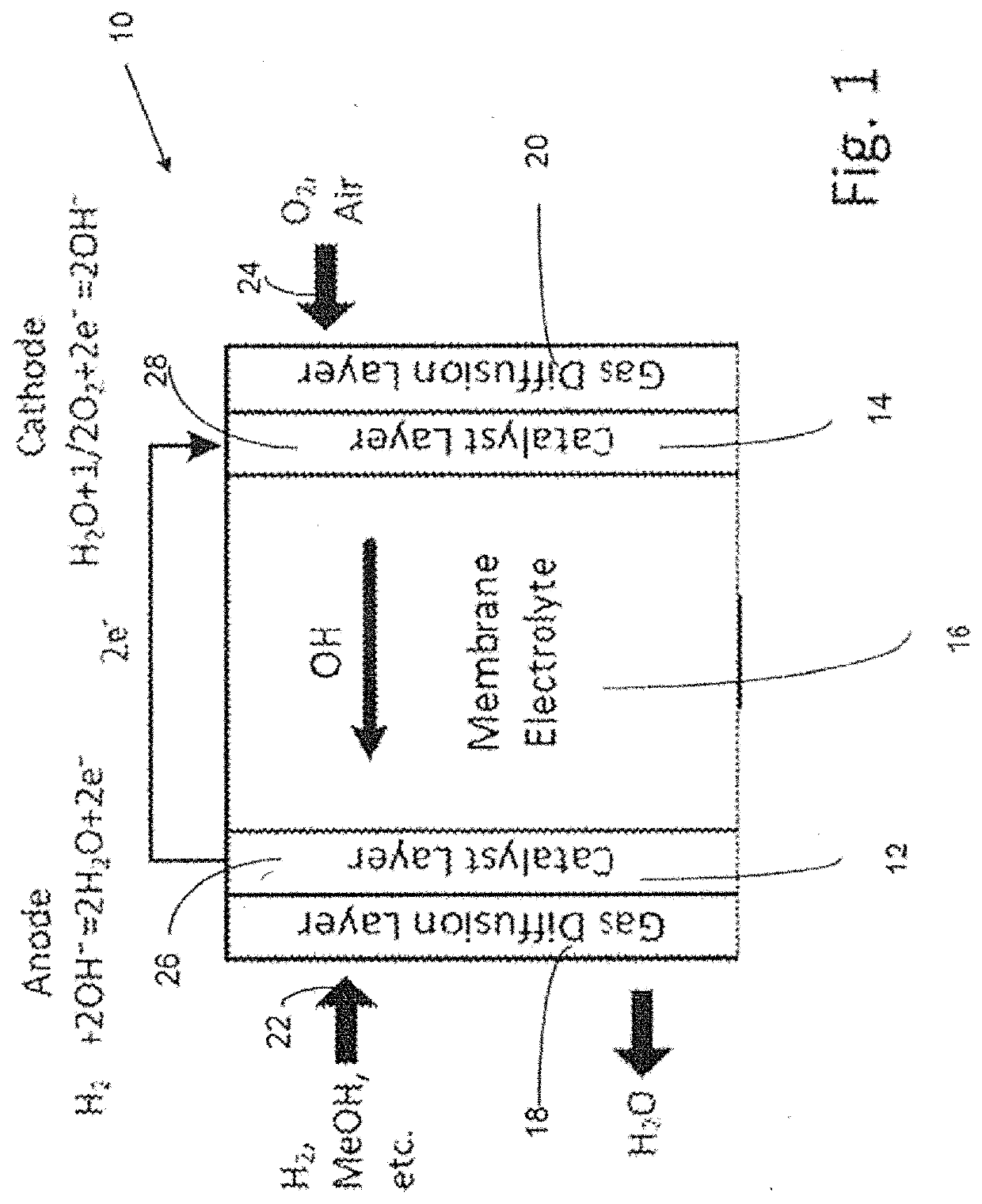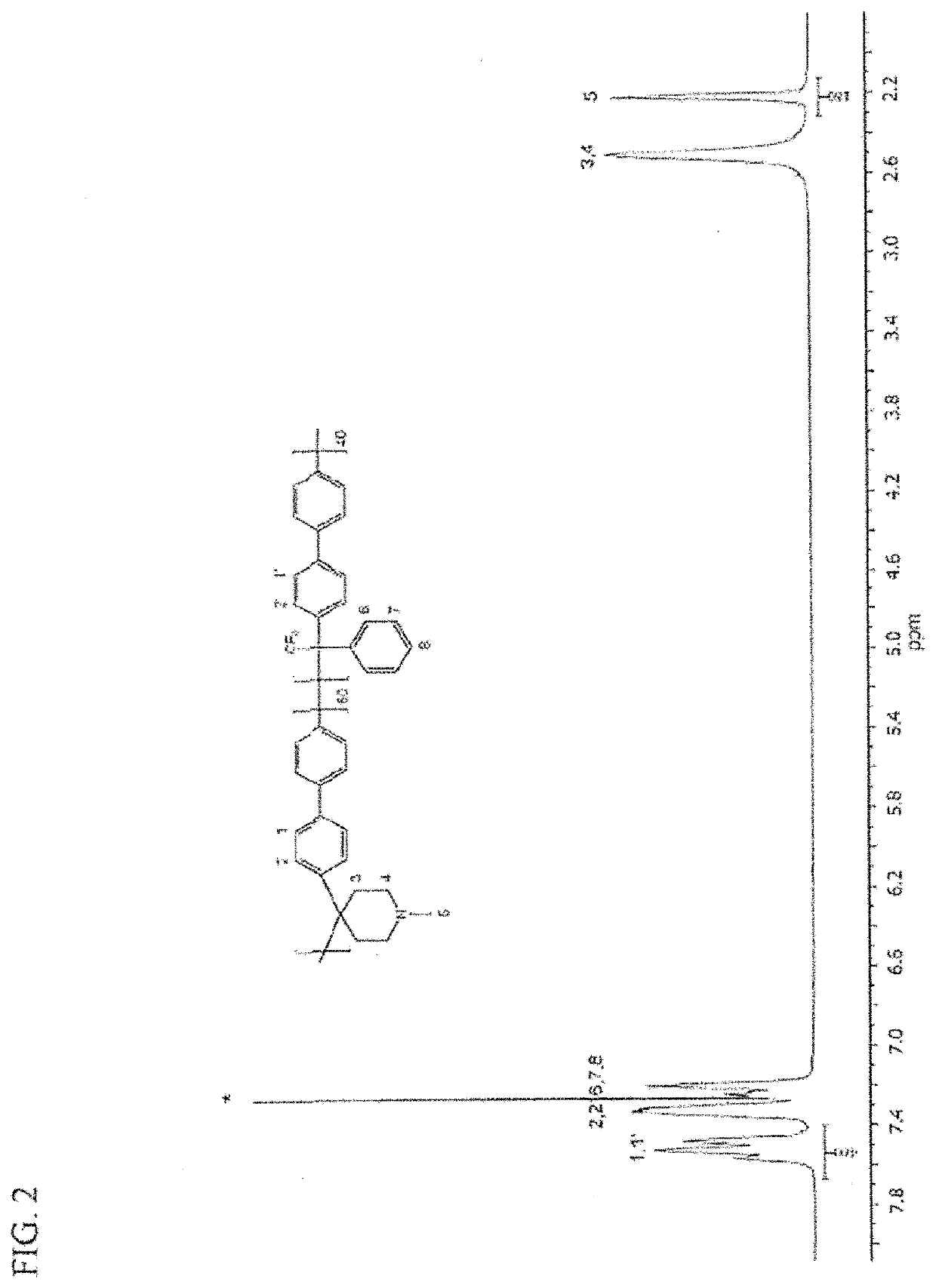Poly(aryl piperidinium) polymers including those with stable cationic pendant groups for use as anion exchange membranes and ionomers
a technology of aryl piperidinium polymer and ionomer, which is applied in the direction of sustainable manufacturing/processing, final product manufacturing, electrochemical generators, etc., can solve the problems of high and achieve the effects of low hydroxide conductivity, low cost and unsatisfactory durability of catalysts
- Summary
- Abstract
- Description
- Claims
- Application Information
AI Technical Summary
Benefits of technology
Problems solved by technology
Method used
Image
Examples
example 1
[0182]A poly(aryl piperidinium) was prepared from N-methyl-4-piperidone, 2,2,2-trifluoroacetophenone and biphenyl (referred to as PAP-1-x, wherein x is the mole ratio of N-methyl-4-piperidone to 2,2,2-trifluoroacetophenone and is from 1 to 100). PAP-1-x was prepared by three major steps: (1) synthesis of a piperidine-functionalized polymer, (2) synthesis of a piperidinium-functionalized polymer, and (3) membrane casting and hydroxide ion exchange. The reaction scheme is depicted below:
[0183](1) Synthesis of a Piperidine-Functionalized Polymer.
[0184]To a 100 mL three-necked flask equipped with overhead mechanical stirrer, N-methyl-4-piperidone (0.6790 g, 6 mmol), 2,2,2-trifluoroacetophenone (0.6965 g, 4 mmol) and biphenyl (1.5421 g, 10 mmol) were dissolved into methylene chloride (10 mL). Trifluoroacetic acid (TFA) (0.5 mL) and trifluoromethanesulfonic acid (TFSA) (10 mL) were then added dropwise over 30 minutes at 0° C. Thereafter, the reaction was continued at this temperature for ...
example 2
[0199]Another example of a poly(aryl piperidinium) is based on N-methyl-4-piperidone, 2,2,2-trifluoroacetophenone and p-terphenyl (PAP-2-x, x is the mole ratio of N-methyl-4-piperidone to 2,2,2-trifluoroacetophenone, x=1 to 100). The reaction scheme for preparing the polymer is as follows:
[0200](1) Synthesis of Piperidine-Functionalized Polymer.
[0201]To a 100 mL three-necked flask equipped with overhead mechanical stirrer, N-methyl-4-piperidone (0.8487 g, 7.5 mmol), 2,2,2-trifluoroacetophenone (0.4353 g, 2.5 mmol) and biphenyl (1.5421 g, 10 mmol) were dissolved into methylene chloride (10 mL). TFA (0.5 mL) and TFSA (10 mL) were then added dropwise over 30 minutes at 0° C. Thereafter, the reaction was continued at this temperature for 36 hours. The resulting viscous, brown solution was poured slowly into ethanol. The white fibrous solid was filtered, washed with water and immersed in 1 M K2CO3 at room temperature for 12 hours. Finally, the white fibrous product was filtered, washed w...
example 3
[0208]Another poly(aryl piperidinium) polymer is based on N-methyl-4-piperidone, 2,2,2-trifluoroacetophenone and p-quaterphenyl (PAP-3-x, wherein x is the mole ratio of N-methyl-4-piperidone to 2,2,2-trifluoroacetophenone, x=1 to 100). The synthesis of PAP-3-x is similar to PAP-1-x and is shown in the reaction scheme below.
PUM
| Property | Measurement | Unit |
|---|---|---|
| Temperature | aaaaa | aaaaa |
| Temperature | aaaaa | aaaaa |
| Temperature | aaaaa | aaaaa |
Abstract
Description
Claims
Application Information
 Login to View More
Login to View More - R&D
- Intellectual Property
- Life Sciences
- Materials
- Tech Scout
- Unparalleled Data Quality
- Higher Quality Content
- 60% Fewer Hallucinations
Browse by: Latest US Patents, China's latest patents, Technical Efficacy Thesaurus, Application Domain, Technology Topic, Popular Technical Reports.
© 2025 PatSnap. All rights reserved.Legal|Privacy policy|Modern Slavery Act Transparency Statement|Sitemap|About US| Contact US: help@patsnap.com



